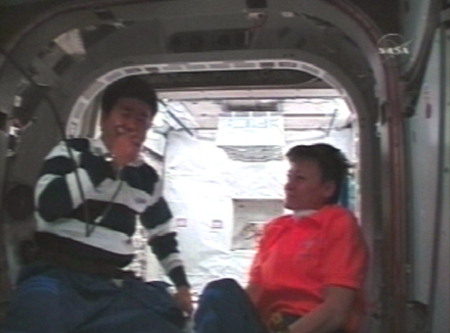This is an archive of information released in the past.
Disclaimer: It may contain broken links or outdated information. Some parts may not function in current web browsers.
*Visit https://humans-in-space.jaxa.jp/en/ for the latest information.

Mission
Flight Day 5

Astronauts Doi and Whitson communicating with the JAXA Flight Control Team in Tsukuba, Japan. (Image credit: NASA)
Today, JAXA achieved another major milestone in the Kibo assembly mission in tandem with NASA and the ISS partners.
Today's activity began with the outfitting of the vestibule between the Japanese Experiment Logistics Module-Pressurized Section (ELM-PS or JLP) and Harmony (Node 2). The outfitting was performed by the ISS commander Peggy Whitson, the STS-123 mission specialists Richard Linnehan and Takao Doi.
At 10:23 a.m., the hatch of the ELM-PS was opened, and astronauts Doi and Whitson simultaneously jumped into the ELM-PS at 10:30 a.m., followed by astronaut Linnehan.
It was the dramatic and memorable moment for Japan in many ways; the first Japan-made human-rated space facility became habitable on orbit and one of the first persons to enter was a Japanese astronaut.
Status of the ELM-PS
On FD4, the ELM-PS, being attached on Harmony (Node 2), was activated, and the crew onboard the ISS and the flight controllers at TKSC confirmed that the module was in good health with all the systems run perfectly as planned.
Astronaut Doi's on-orbit activities (FD5)
Astronaut Doi, along with astronauts Whitson and Linnehan, worked on the outfitting inside the vestibule between the ELM-PS and Harmony (Node 2). Before entering the ELM-PS, astronaut Doi checked the shell temperature of the ELM-PS on the minimum keep alive monitor (MKAM). Once the outfitting was completed, astronaut Doi and the other two crewmembers were readied for the ingress. Putting on the masks and gurgles, they entered the ELM-PS.
In the ELM-PS, they checked out the lights, inter-module ventilation (IMV) and other equipments.
Thereafter, astronaut Doi began his scheduled tasks inside the ELM-PS. Since his tasks went so smoothly, astronaut Doi has done some of the tasks that were originally planned on FD6; he completed rack reconfigurations for the Electrical Power System (EPS), Data Management system (DMS), and Work Station (WS) racks.
For further information, please refer to the NASA STS-123 Mission Status Report
*All times are Japan Standard Time (JST)
| Copyright 2007 Japan Aerospace Exploration Agency | Site Policy |